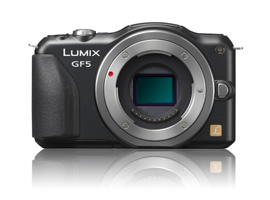Introduction
Panasonic’s Lumix DMC-GF5’s sensor received a mediocre rating of 50. This score ties it with the G3, and indicates that changes made to this newer camera were mostly cosmetic renovations made to the outside, and new software features found in the camera’s interior.
At 20.5 bits, the camera did register respectable color depth, and would make a good purchase for newbie photographers who enjoy taking portraits of friends and family.
The GF5 also had an acceptable performance in dynamic range, providing a maximum 10 EVs at around 160 ISO. However, detail preservation might be lost in shadows and highlights at higher ISOs, as the camera’s sensor starts a steady decline in dynamic range performance after 400 ISO.
The GF5’s significant flaw is its ISO. In the sports category, DxOMark scientists observed the camera’s image quality deteriorating after about 575 ISO. This makes it a problematic camera for photographers who love to take pictures in dimly lit or dark environments.
Panasonic Lumix DMC-GF5 vs. Panasonic Lumix DMC GX1 vs Panasonic Lumix DMC GF3
The Panasonic Lumix DMC-GF5’s predecessor is the Lumix DMC-GF3. It launched last year to mixed reviews, most of which were focused on it shrinking 17% in size and 16% in weight over the Lumix DMC-GF2. This shrinking effect also seemed to impact its sensor quality, as it regressed a few points from the GF2.
Did Panasonic repeat the same mistake in sensor quality regression with the GF5?
The short answer is no. The GF5 equalized the GF3 in DxOMark’s overall sensor quality score, and both had near identical results in the portrait and landscape categories.
Their most distinguishing difference was observed in the sports category, or lowlight ISO, with a slight nod given to the newer GF5 for having an ISO score of 573 compared to the GF3’s 459 ISO score.

These results provide evidence that Panasonic likely didn’t evolve the sensor’s quality. Rather, the company placed emphasis on improving the exterior of the camera, improving existing components like audio and video capabilities, and adding features like 14 creative filters that superimpose artistic or nostalgic photo-like qualities onto an image.
Photographers sold on getting a new compact-hybrid DSLR-like camera from Panasonic should also consider the Lumix DMC-GX1. It costs $100 more than the GF5’s $599 (USD) price tag, but the GX1’s 16-megapixel camera sensor registered slightly better quality over the GF5 in:
- Lowlight, with a 1/3 stop improvement, making it a better camera for night-oriented photographers.
- Dynamic range, notching only a modest improvement over the GF5.
Panasonic Lumix DMC-GF5 vs. Sony NEX-5N vs. Olympus PEN EPL-3
The hybrid digital still camera market is crowded. Panasonic’s Lumix DMC-GF5 has more than a dozen competitors, with some of its stiffest headwinds coming from rivals Olympus and Sony.
Sony’s NEX-5N, while costlier at $860, backs up that price with a number of features that outshine Panasonic’s Lumix DMC-GF5. The NEX-5N boasts a bigger screen, better battery life, and a larger and more superior sensor.
Sony NEX-5N’s 16.14-megapixel sensor, receiving an overall DxOMark sensor score of 77, was buoyed above the GF5 in:
- Lowlight ISO, with its sensor nearly 1 full f-stop better than the GF5. The NEX-5N pushes the limits of good image quality recorded at a high ISO setting, especially for a hybrid camera. The NEX-5N’s breaking point was around 1079 ISO, making it an ideal piece of equipment for dark shooting conditions.

- Color depth, registering a full 3.1 bits higher than the GF5, giving it the ability to capture a wider variety of colors. This camera will work great for portraits and detail shots.
- Dynamic range, at 12.7 EVs, the NEX-5N can secure many of the details difficult to capture in high contrast pictures that include dark shadows and bright highlights.

Olympus, who collaborated with Panasonic on the Micro Four Thirds system, also has a number of compact hybrid cameras that share this 4:3 technology. Many of these Olympus cameras consequently go head-to-head with the GF5, including the similarly performing one-year-old PEN EPL-3.
The PEN EPL-3 provides:
- Slightly smaller lowlight ISO quality compared to the GF5.
- A better value, priced at $460 (USD), the camera is about $140 cheaper than the GF5.
- Slightly better color depth and an insignificant .1 EV improvement in dynamic range over the GF5.

Panasonic’s Lumix DMC-GF5’s offers some new tricks in a remodeled GF3 camera body. It whips up better video and audio options, and it incorporates new user features like creative control filters, and scene guide modes (provides beginning photographers with picture guides on how a professional photographer might shoot a particular scene).
The GF5 also disappoints in its sensor quality. Panasonic made no significant evolutionary changes to the GF5’s sensor, putting the Lumix DMC-GF line at risk from hungry competitors’ eager to pick off prospective Panasonic customers.








DXOMARK encourages its readers to share comments on the articles. To read or post comments, Disqus cookies are required. Change your Cookies Preferences and read more about our Comment Policy.